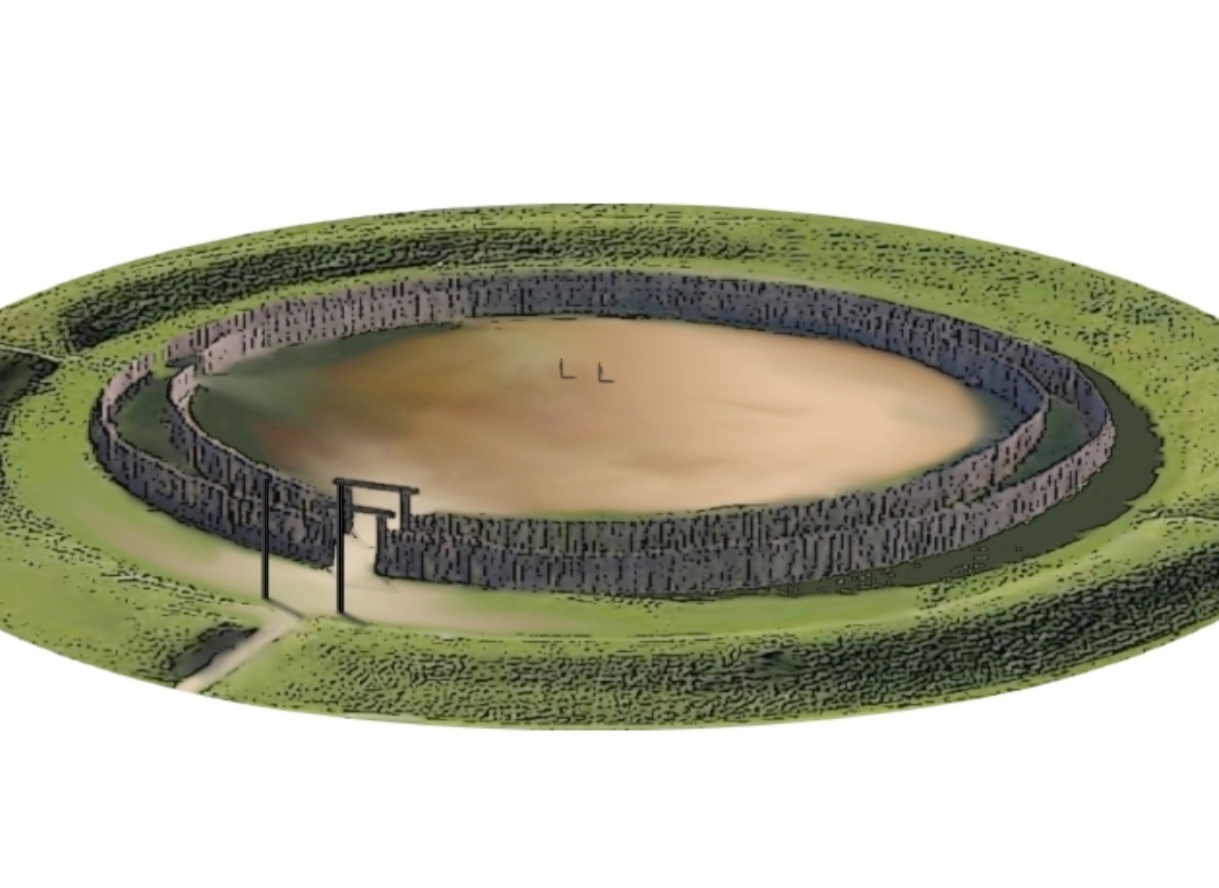Stroke-ornamented Ware on:
[Wikipedia]
[Google]
[Amazon]
The Stroke-ornamented ware (culture) or (German) Stichbandkeramik (abbr. STK or STbK), Stroked Pottery culture, Danubian Ib culture of V. Gordon Childe, or Middle Danubian culture is the successor of the
 An unusual structure associated with STK has been found at Goseck, southwest of Berlin in
An unusual structure associated with STK has been found at Goseck, southwest of Berlin in

File:Stroke-ornamented Ware, City of Prague Museum, PJ0000062, 175581.jpg, Stroke-ornamented Ware, City of Prague Museum
File:MUFT - Bad Frankenhausen Stichbandkeramik Kumpf.jpg, Museum for Prehistory, Thuringia
File:Smac Neolithikum 061.jpg, State Museum of Archaeology, Chemnitz
File:Schuchhardt Stichbandkeramik Benditz.jpg, State Museum of Prehistory, Berlin
File:Landesmuseum Württemberg Stuttgart Neolithikum 023.jpg, State Museum of Württemberg, Stuttgart
File:Smac Neolithikum 013.jpg, Ceramic figurine
File:Necklace, river mussels, Stroke-ornamented Ware culture, City of Prague Museum, 200350.jpg, Shell necklace
File:Landesmuseum Württemberg Stuttgart Neolithikum 027.jpg, Bracelets
Stichbandkeramik (Baldia)
{{DEFAULTSORT:Stroke-Ornamented Ware Culture Archaeological cultures of Europe Stone Age Europe Archaeological cultures in Austria Archaeological cultures in the Czech Republic Archaeological cultures in Germany Archaeological cultures in Poland
Linear Pottery culture
The Linear Pottery culture (LBK) is a major archaeological horizon of the European Neolithic period, flourishing . Derived from the German ''Linearbandkeramik'', it is also known as the Linear Band Ware, Linear Ware, Linear Ceramics or Incis ...
, a major archaeological horizon of the European Neolithic
The European Neolithic is the period from the arrival of Neolithic (New Stone Age) technology and the associated population of Early European Farmers in Europe, (the approximate time of the first farming societies in Greece) until –1700 BC (th ...
in Central Europe
Central Europe is a geographical region of Europe between Eastern Europe, Eastern, Southern Europe, Southern, Western Europe, Western and Northern Europe, Northern Europe. Central Europe is known for its cultural diversity; however, countries in ...
.
The STK flourishes during approximately 4900-4400 BC.
Centered on Silesia
Silesia (see names #Etymology, below) is a historical region of Central Europe that lies mostly within Poland, with small parts in the Czech Silesia, Czech Republic and Germany. Its area is approximately , and the population is estimated at 8, ...
in Poland
Poland, officially the Republic of Poland, is a country in Central Europe. It extends from the Baltic Sea in the north to the Sudetes and Carpathian Mountains in the south, bordered by Lithuania and Russia to the northeast, Belarus and Ukrai ...
, eastern Germany
Germany, officially the Federal Republic of Germany, is a country in Central Europe. It lies between the Baltic Sea and the North Sea to the north and the Alps to the south. Its sixteen States of Germany, constituent states have a total popu ...
, and the northern Czech Republic
The Czech Republic, also known as Czechia, and historically known as Bohemia, is a landlocked country in Central Europe. The country is bordered by Austria to the south, Germany to the west, Poland to the northeast, and Slovakia to the south ...
, it overlaps with the Lengyel horizon to the south and the Rössen culture to the west.
Description
The STbK and the Notenkopfkeramik (Musical Note pottery) are a development of the LBK. Much it features incised zig-zag bands going around the pot, with punctures at the line segment junctions. The STK abandons incision in favor bands of small punctures, also in zig-zag patterns, with a vertical band dividing each angle. The effect is a band pattern of contiguous A-frames. Where the Musical Note pottery expanded east over theBug River
The Bug or Western Bug is a major river in Central Europe that flows through Belarus (border), Poland, and Ukraine, with a total length of .Vistula
The Vistula (; ) is the longest river in Poland and the ninth-longest in Europe, at in length. Its drainage basin, extending into three other countries apart from Poland, covers , of which is in Poland.
The Vistula rises at Barania Góra i ...
and Elbe
The Elbe ( ; ; or ''Elv''; Upper Sorbian, Upper and , ) is one of the major rivers of Central Europe. It rises in the Giant Mountains of the northern Czech Republic before traversing much of Bohemia (western half of the Czech Republic), then Ge ...
. The spread of this style must have been basically the transmission of cultural objects.
The homes of the STK people show a slight modification that became a major feature of later cultures: one end of the long house was made shorter than the other to achieve a trapezoidal shape. The reason for this modification remains obscure. Also, the STK people developed a preference for cremation rather than burial. The preceding early LBK had used both methods.
Goseck circle
 An unusual structure associated with STK has been found at Goseck, southwest of Berlin in
An unusual structure associated with STK has been found at Goseck, southwest of Berlin in Saxony-Anhalt
Saxony-Anhalt ( ; ) is a States of Germany, state of Germany, bordering the states of Brandenburg, Saxony, Thuringia and Lower Saxony. It covers an area of
and has a population of 2.17 million inhabitants, making it the List of German states ...
: a large, double concentric ring of post holes pierced by gates and surrounded by a circular ditch. The placement of the gates and some of the posts lead some investigators to hypothesize an observatory similar to Stonehenge, but in wood rather than stone; i.e., the posts mark some positions of celestial bodies.
Gallery

References
External links
Stichbandkeramik (Baldia)
{{DEFAULTSORT:Stroke-Ornamented Ware Culture Archaeological cultures of Europe Stone Age Europe Archaeological cultures in Austria Archaeological cultures in the Czech Republic Archaeological cultures in Germany Archaeological cultures in Poland